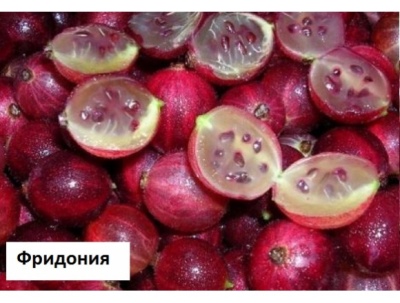
- Authors: Canadian selection
- Growth type: vigorous
- Description of the bush: upright, not spreading
- Escapes: powerful
- Berry size: medium and large
- Berry weight, g: up to 7
- Berry shape: rounded
- Berry color: bright ruby
- Taste: sweet, with a rich aftertaste of wild strawberry, pineapple and fresh linden honey
- Winter hardiness: high
Gooseberries of the Canadian selection Fridonia won the hearts of Russian summer residents by their lack of thorns, compact size and abundant fruiting. Its beautiful, brightly colored berries can become an exquisite delicacy in the diet of children and adults. The variety is well suited for growing even by inexperienced gardeners, requires minimal maintenance during the season.
Description of the variety
Vigorous bushes have straight, strong shoots that are not prone to the formation of a spreading crown. Plant height reaches 150 cm. Branches are thornless, powerful. There are many leaves, they are medium-sized, light green, at the top of the crown they can be painted brighter.
Characteristics of berries
Berries are not prone to shedding when they reach maturity. The size varies from medium to large, with a berry weight of up to 7 g. The shape of the fruit of this gooseberry is round, the color is bright ruby.
Taste qualities
Fridonia has very unusual flavors. The berries of this gooseberry are sweet. The aftertaste pleases with hints of wild strawberries, fresh lime honey, pineapple.
Ripening and fruiting
The gooseberry is medium late. The fruits are ready to be harvested in July. Fruiting begins as early as 3-4 years from the moment of planting, lasts up to 40 years in a row.
Yield
Fridonia gives up to 8 kg of ripe berries from a bush.
Growing regions
This gooseberry variety was bred in Canada, which is climatically close to Russia. It takes root well in the Urals and Siberia, in the North-Western regions, in the Moscow region and in the Central regions.
Landing
For the gooseberry Fridonia, a place is required that is not occupied by large-sized plants, free from abundant shade from fences, walls of houses, and outbuildings. It is important to find a spot that has full sun for most of the day. The soil should be sufficiently moist, but not soggy, as the superficial root system will rot. Gooseberry prefers soil with neutral acidity, fertile, air-permeable.
Planting can be carried out in spring and autumn. Each option has its own advantages. Spring seedlings have time to get stronger by winter. But the fall planting allows you to better prepare the buds for waking up after winter. In this case, it will be possible to count on the fact that the seedlings will actively grow in the new season.
The interval between the pits for planting gooseberries of this variety is made about 2 m.The depth is enough up to 40 cm, the diameter is better to choose, focusing on the size of the root system. If the soil is not fertile enough, it is mixed with organic and mineral fertilizers. Young bushes are installed in the holes so that the root collar is 70-90 mm below the edge.

Growing and care
Once the planting process is complete, the plants need to be well cared for. Long shoots are shortened before winter. In early spring, before the start of sap flow, the plants are examined annually.During this period, all damaged, broken branches are cut out. Autumn reorganization involves the removal of six-year-old branches that have fruited.
Thinning the crown is also useful. If it becomes very thickened, the berries become smaller, and they ripen worse. It is important to remove excess shoots, helping sunlight to penetrate into the crown. Places of cuts on shoots more than 10 mm in diameter are treated with garden pitch.
You do not need to water the bushes constantly. Periodically, the earth is moistened with clean warm water. It is worth paying attention to the condition of the soil. If it dries up, the leaves begin to wither on the branches, watering is definitely necessary.
Fertilization will also help stimulate growth. Depending on the growing season and the needs of the plant, these can be natural sources of nitrogen, as well as ready-made potash and phosphorus mixtures.




In order for the gooseberry to produce a good harvest, it is necessary to devote time to disease prevention.
Resistance to adverse climatic conditions
Fridonia is characterized by good winter hardiness. The originator claims that the variety can withstand frosts down to -45 degrees. In general, gooseberries are drought-resistant, but long periods without watering can tolerate rather poorly.

Review overview
Amateur gardeners in Russia have been familiar with the Fridonia variety for over 10 years. According to most of them, the variety surpasses many others in the number of berries on the bushes. Plants give bountiful harvests annually, without depletion for many years. The taste is also flawless, juicy and sweet, recognizable, especially pleasant as an addition to smoothies, desserts, baked goods.
It is noted that the variety multiplies easily, gives abundant growth. Ripe berries are decaying, they can hang on bushes for a long time without losing taste and aroma.
No obvious flaws were found in this gooseberry. But some summer residents note that the frost resistance indicators do not meet the declared ones. Therefore, it is better for the safety of shoots to cover them for the winter with agrofibre. And also by the fall, signs of the development of fungal infections may appear on the plants. In this case, summer residents recommend cutting out all places of infection with pruning shears, and then treating them with copper sulfate.



































































